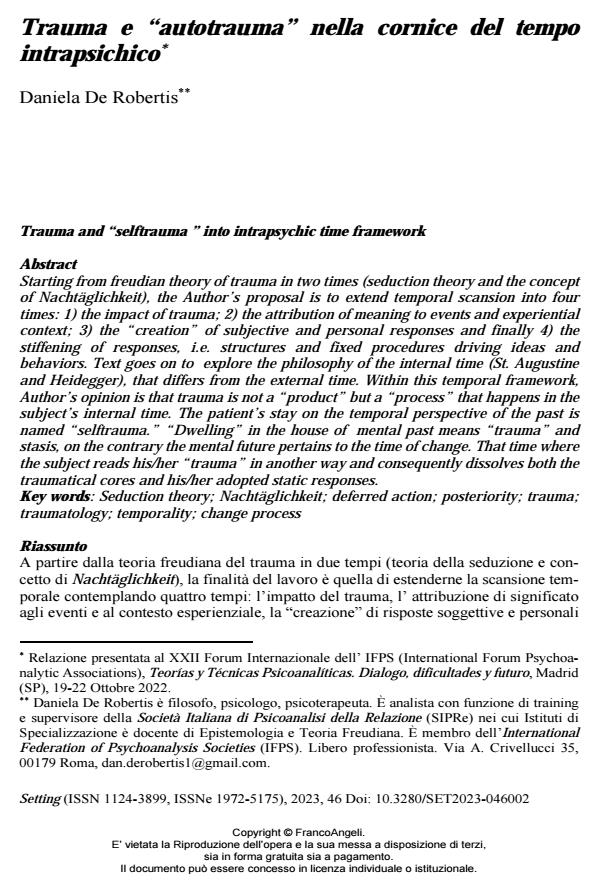Trauma and “selftrauma ” into intrapsychic time framework
Journal title SETTING
Author/s Daniela De Robertis
Publishing Year 2024 Issue 2023/46 Language Italian
Pages 17 P. 37-53 File size 228 KB
DOI 10.3280/SET2023-046002
DOI is like a bar code for intellectual property: to have more infomation
click here
Below, you can see the article first page
If you want to buy this article in PDF format, you can do it, following the instructions to buy download credits

FrancoAngeli is member of Publishers International Linking Association, Inc (PILA), a not-for-profit association which run the CrossRef service enabling links to and from online scholarly content.
Starting from freudian theory of trauma in two times (seduction theory and the concept of Nachtäglichkeit), the Author’s proposal is to extend temporal scansion into four times: 1) the impact of trauma; 2) the attribution of meaning to events and experiential context; 3) the “creation” of subjective and personal responses and finally 4) the stiffening of responses, i.e. structures and fixed procedures driving ideas and behaviors. Text goes on to explore the philosophy of the internal time (St. Augustine and Heidegger), that differs from the external time. Within this temporal framework, Author’s opinion is that trauma is not a “product” but a “process” that happens in the subject’s internal time. The patient’s stay on the temporal perspective of the past is named “selftrauma.” “Dwelling” in the house of mental past means “trauma” and stasis, on the contrary the mental future pertains to the time of change. That time where the subject reads his/her “trauma” in another way and consequently dissolves both the traumatical cores and his/her adopted static responses.
Keywords: Seduction theory; Nachtäglichkeit; deferred action; posteriority; trauma; traumatology; temporality; change process
- Ricoeur P. (1983). Tempo e racconto. Trad. it., vol. I, Milano: Jacabook.
- Agostino (1965). Confessioni. Roma: Città Nuova.
- Aristotele (1968). La Fisica . Bari: Laterza.
- Bergson H. (1932). Le due fonti della morale e della religione. Trad. it., Milano: SE, 2006.
- Bergson H. (1889). Saggio sui dati immediati della coscienza. Trad. it., Reggio Emilia: Città Armoniosa, 1983.
- Breuer J. & Freud S. (1893-95). Studi sull’isteria. In OSF, vol. I, Torino: Boringhieri, 1967.
- Civitarese G. (2015). I poscritti di Dora. Riv. di Psicoan. , LXI(3): 665-683.
- Charcot M. (1897). Isterismo. In Trattato di medicina , vol. VI, Torino: UTET, pp. 477-536.
- Damasio A.(1999). Emozione e coscienza . Trad. it., Roma: Adelphi, 2000.
- De Robertis D. (2016). Tempo e tempi del trauma. Una curvatura sull’adolescenza. In Vanni F. (a cura di) Clinica psicoanalitica dell’adolescente. Milano: FrancoAngeli.
- De Robertis D. (2015). Costruzioni narrative e dialettica dell’intratemporalità nel life span. Ripensare il tempo psichico nella cura psicoanalitica. Ricerca Psicoanalitica, XXVI(2): 19-44.
- De Robertis D. (2009). Coscienza , livelli di espansione e tempo. Alcuni spunti per la cura psicoanalitica. Ricerca Psicoanalitica, XX(1): 123-143.
- De Robertis D. (2008-2009). Alcune osservazioni sul tempo fenomenologico applicate al processo e alla cura analitica. La Pratica Analitica, 6: 79-97.
- De Robertis D. & Biondi D. (2023). Inconscio potenziale, default network e metafora. Una possibile alleanza per la cura. Psichiatria e Psicoterapia, 42(1): 28-50.
- Dorato M. (1997). Futuro aperto e libertà. Un’introduzione alla filosofia del Tempo. Bari: Laterza.
- Edelman G.M. (1992). Sulla materia della mente. Trad. it., Milano: Adelphi, 1993.
- Edelman G.M. & Tononi (2000). Un universo di coscienza. Trad. it., Torino: Einaudi.
- Freud S. (1895). Progetto di una psicologia per neurologi. In OSF, vol. II, Torino: Boringhieri, 1968.
- Freud S. (1950). Lettere a Fliess. Bonaparte M., Kris E., Freud A. (eds.). Trad. it., Torino: Boringhieri, 1968.
- Heidegger N. (1924). Il concetto di tempo. Trad. it., Adelphi, Milano, 1999.
- Heidegger N. (1927). Essere e tempo. Trad. it., UTET, Torino, 1969.
- Kristal H. (1978). Affetto, trauma e alessitimia. Trad. it., Roma: Ed. Magi, 2007.
- Lazarus R. C. (1991). Emotion and Adaptation. New York: Oxford University Press.
- Lazarus R. C. & Lazarus B. (1994 ). Passion and reason : Making sense to our emotions. New York: Oxford University Press.
- Minkowski E. (1933). Il tempo vissuto. Trad.it., Torino: Einaudi, 2004.
- Modell A. H. (1994). Memory and Psychoanalytic Cure. Can. J. Psychoanal., 2: 89-101.
- Modell A.H. (1990). Per una teoria del trattamento psicoanalitico. Trad. it., Milano: Raffaello Cortina, 1994.
- Ogden T.H. (2004). The Analytic Third: Implications for psychoanalytic theory and tecnique. Psychoanalytic Quarterly, 73(1): 167-195.
- Schacter D.L. (2001). The seven sins of memory: How the mind forgets and remembers. Boston: Houghton Mifflin.
- Schachter S. & Singer J.E. (1962). Cognitive social and psychological determinants of emotional state. Psychological Rewiew, 69: 379-399.
- D. J. Siegel (1999). La mente relazionale. Trad. it., Milano: Cortina, 2001.
- Stolorow R. D. (2007). Trauma ed esistenza umana. Trad. it., Roma: Giovanni Fioriti, 2013.
- Strachey J. (a cura di) (1964). The standard edition of the complete psychological works of Sigmund Freud. London: Macmillan.
- Tronick E. (2008). La regolazione emotiva. Nello sviluppo e nel processo terapeutico. Trad. it., Milano: Raffaello Cortina.
- Tronick E. & Gold C.M. (2020). Il potere della discordia. Trad. it., Milano: Raffaello Cortina, 2021.
Daniela De Robertis, Trauma e “autotrauma” nella cornice del tempo intrapsichico in "SETTING" 46/2023, pp 37-53, DOI: 10.3280/SET2023-046002